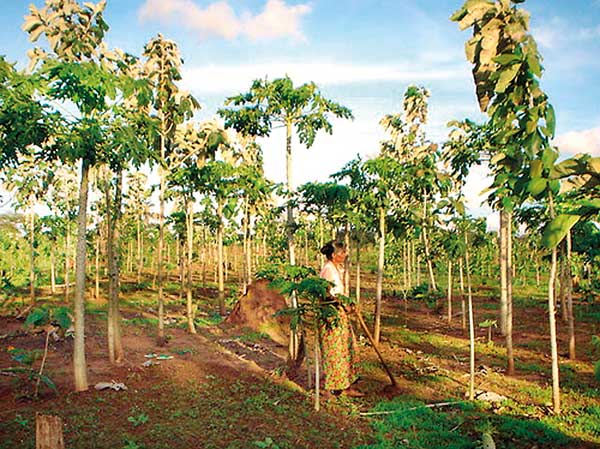Reply To:
Name - Reply Comment
 by Dr. N.YOGARATNAM
by Dr. N.YOGARATNAM
Commercial agroforestry, aimed at integrating tree crops with agricultural crops and animals to increase land productivity, is the way to go towards enhancing timber and food production.
It is not uncommon to see vegetable and fruit plants like sugarcane, banana and pineapple alongside rubber and oil palm in many Asian countries. In some smallholdings and estates, animals such as sheep and cattle feed on weeds in between the role of this short term crops. Some crop plantations have even the timber species sentang and teak.
Maximizing land use
These mixed farming activities now emerging and gaining popularity, are refer to as agroforestry. In essence, agroforestry is a land-use-system involving integration of tree crops and animals simultaneously or sequentially on the same unit of land aim at maximising land use and increasing land productivity. Agroforestry in countries like Sri lanka, Malaysia, as in other parts of the world, is an old farming practice. The earliest approach involves mixing of various components on vacant land usually around home garden. These includes fruit trees, bamboo, poultry, vegetables and other short-term crops as well as animal rearing.
However, these combination are traditionally and unsystematic and the practice is solely to subsidise the farmers’ basic needs for food and fuel. Commercial-scale agroforestry in rubber was first initiated in 1920s with the planting of rubber trees in the coffee plantations. In these system, rubber trees were planted in the inter-rows of the coffee plants. But the approach, although economically viable, did not last long. As the market value of the latex increased and the coffee price dropped, the coffee plants were removed, leaving the rubber trees under monoculture.
Since then the planting of tree crops is in the form of monoculture and has been successfully with perennial crops especially rubber, cocoa and oil palm. In recent years, resulting from the declining return from the monoculture plantation, coupled with the need to obtain early income, agroforestry in the form of inter-cropping or integrated farming has emerged as an important land use system. It has been established mainly in immature cocoa, coconut, rubber and oil palm smallholdings and estates.
Added components
The added components included short-termed crop such as pineapples, vegetables, chillies and maize. In some trees plantations, lives stock rearing (eg sheep and poultry) and mushroom cultivation are commercially introduced as agroforestry. They have been proven technically feasible and economically viable during the early immaturity phrase of the main crops.
However, as a tree canopy closes, the yield of added component declines and the whole integration system ceases. In order to make agroforestry sustainable , the avenue or hedge planting system has been developed in mainly rubber plantations. Basically, it involves planting of trees crop in single, double or triple rows in the form of hedges with wide spacing between the hedges. The wide spaces provide long-term economic activities without compromising on the tree stand , growth and yield. Such system is being practiced by smallholders and some estates owners with the planting of fruit trees and even timber and medicinal plants in wide avenue. Other permanent agroforestry systems that are suitable in plantations here include perimeter planting and block planting. The re-emergence of commercial agroforestry stems from the changing scenario of the forestry and agriculture Sector.
In the forestry sector, the natural forest is no more seen as timber or non-timber resources for the expanding forest-based industry. By 2011, a deficit of more than 13 million cubic metres of timber were expected in Malaysia. Besides timber, non timber species such as bamboo, rattan and even medicinal plants will be in short supply. Recognising the need to sustain future supply of timber, Malaysia has, since 1980, developed forest plantations as an alternate source of wood supply.
Being new, the development of forest plantations is constrained by many factors and the pertinent ones are land, finance labour and long gestation period. As a measure to reduce the financial burden and thereby attract the private sector to invest in forest plantation, the Governments introduced several incentives. These incentives, which include pioneer status and investment tax allowance, have of late shown to be inadequate. In view of the need to increase domestic food and timber production, the Government has emphasised, among others, the agroforestry approach.

Minimising search for new land
Agroforestry can increase land productivity and hence minimise some of the above-mentioned issues. Being able to be implemented on either existing agricultural land and forest plantation as well as on idle and damaged forest, it will certainly avoid having to search for new land, thus relieving pressure on the natural forest. It will also improve income and provide early returns of investment, thereby sustain productivity of both agriculture and forest plantations. If successfully implemented country wide, it would go a long way towards enhancing national timber and food production. In view of the attractive benefits of agroforestry, it has been made as one of the strategic action plans of the National Agricultural Policy of Malysia.
Agroforestry has important roles to the forest environment and social activities of the forest dwellers. It improves biodiversity, increases biomass production and provides better microclimate. Where agroforestry is developed on damage forest or land area resulting from shifting cultivation, it will lead to the development of permanent resettlement centres. This, among others, will discourage collections of items such as bamboo, herbal plants and rattan over wide areas and hence leave the forest undisturbed.
In essence agroforestry has the potential to transform “wasteland” or disturbed forest into an integrated productivity protective system. Commercial agroforestry has been well adopted by many countries. It is gaining popularity in China and in some nation in Africa, Southeast Asia and Europe as viable practises at increasing land productivity. However the establishment of agroforest in Sri Lanka is relatively new and has just begun to appear in tree crop plantations.
With the many benefits of agroforestry, in particular at increasing land productivity and the possible Government support for the increased timber and food production coupled with the availability of several agroforestry designs, the future agroforestry can be brighter in Sri Lanka. Already, plantations are practising such a land use system in their rubber and oil palm holdings. They are consistently getting additional income at lease during the immature phrase of their main tree crop. When this develops permanently over a longer period, the issues of timber and food shortage can be overcome.
Indonesian example
Alternative rubber agroforestry systems are raising incomes, retaining biodiversity and increasing rubber production in Indonesia.
Rubber production began in Indonesia in the early twentieth century. It is one of the country’s most important crops as many Indonesian farmers gain some or all of their income from growing and selling rubber.
Many NGOs launched their research on rubber agroforestry in Indonesia in the mid-1990s. By then, many development agencies had already spent millions of dollars promoting high-yielding monoclonal rubber plantations, and these were beginning to replace traditional jungle rubber systems on many smallholdings.
“The monoclonal plantations gave farmers much higher yields than jungle rubber gardens, and therefore better incomes,” says an economist . “But there were also some disadvantages.” They required considerable capital investment, which many households could not afford. The conversion of jungle rubber to monoclonal rubber systems was also causing significant losses of biodiversity.
These trends, and the conversion of jungle rubber to oil palm, prompted the Center and its partners to devise alternative systems of rubber agroforestry that would increase smallholder yields while retaining some biodiversity.
Selecting the right technology
“The grower’s main consideration was selecting technologies that would be suitable for smallholders who had little cash, limited family labor, small land holdings, and little or no access to high-yielding planting materials and other inputs,” says a scientist at the Indonesian Rubber Research Institute.In 2010, researchers compared rates of adoption in 30 villages in Sanggau District, West Kalimantan, and 30 villages in Bungo District, Jambi. In villages where the project had been active, the area and number of households adopting the new systems increased tenfold. More surprisingly, rates of adoption in villages where the project had not been active were almost as high.
The researchers identified several reasons for this. First, smallholders in Indonesia had heard of clonal rubber varieties and their advantages, and many had tried them not always with success in the past. This meant that it did not require a huge effort to promote new clones. Second, the word agroforestry had been a key source of information about clones for farmers who were not associated with its present or past projects. This suggests that its dissemination methods in local languages were highly effective. Finally, the government and development agencies had actively promoted the use of new clones.
Studies in Bungo District of Indonesia found jungle rubber systems that harbor 689 different trees, mammals, and birds, while rubber and oil-palm mono-cultures contain just a handful. A 60-year-old rubber agroforest stores roughly the same amount of carbon as a 25-year-old secondary forest, 110 tons per hectare. This is just under half the amount found in primary forest in the district and means that jungle rubber could have an important role to play in sequestering and storing carbon under schemes designed to reduce emissions from deforestation and degradation.The environmental importance of jungle rubber prompted the World Agroforestry Centre and some of its local partners to investigate the possibility of establishing a reward system that would encourage farmers to retain their jungle rubber and the important ecosystem services it provides. Researchers are also looking into eco-certification, which could help prevent farmers from intensifying their rubber production. These two avenues for farmers to benefit from ‘jungle’ rubber remain a work in progress.
(The writer can be contacted at [email protected])